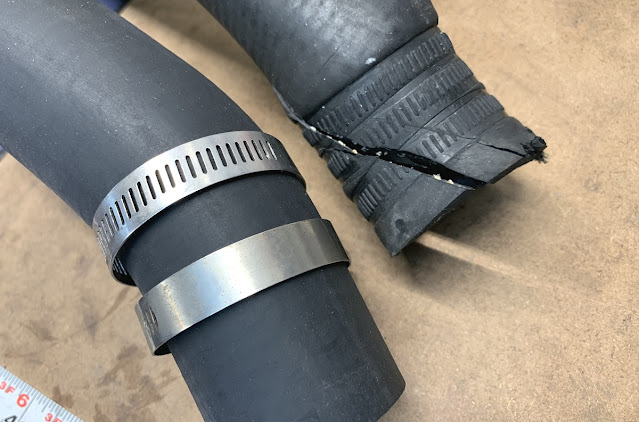Replacing radiator hoses is part of the long-term maintenance program for an internal-combustion, water-cooled vehicle.
In the case of the C3 Corvette, removing and installing a lower radiator hose (if the factory shroud is present), is a challenging, frustrating, and even infuriating task. There's no other way to describe it.
My original plan was to film the process in detail, but as you probably know, I work alone. So when I found myself under my Corvette trying to loosen the lower hose clamp with my right hand while holding the hose with my left, I was going to use my third hand to hold the camera, but then I remembered I only have two!
I hope the video at the end of this article will give you a good understanding of the struggle of removing and installing a new lower radiator hose, as well as tips and tricks I utilized to get mine properly installed and leak-free.
The upper radiator hose is so easy to remove and replace there's not much to talk about, except for routing it properly so it does not rub against the radiator shroud, the air intake, or the alternator bracket.
The photo above is from the Haynes 1968-1982 Corvette repair manual. Having a copy handy is a good idea. This is the only publication that showed a good picture of the upper radiator hose and its routing.
If the upper radiator hose contacts the alternator bracket, you can adjust it slightly so it does not or, alternatively, add a rubber cushion to insulate it.
Again, the upper radiator hose is super easy to replace, although the task may be complicated a bit if your car still has the smog pump which you must move out of the way to get the old lower radiator hose out and a new one installed.
THE LOWER RADIATOR HOSE
If your Corvette's radiator, core support, and shroud are out, this is the perfect time to install a new lower radiator hose.
However, IT IS possible to remove the old hose and install a new one with all the aforementioned parts in place. It may not be easy, but it is doable.
Having a QuickJack portable lift available made this job bearable. If you have a full-size car lift or access to one, you are golden!
The first thing I did was to remove the lower radiator hose shield shown above, held in place by an 11/16" nut. That shield protects the hose from the a/c belt.
Old hoses get "welded" to the water pump and the lower radiator coolant outlet neck. The best and quickest solution is to use a utility knife and slice the hose longways right where it contacts the water pump and radiator. Then peel it off those areas.
LUBRICATION
To make installation as painless as possible, I lubed the lower radiator hose inside ends to get them to slide over the water pump and lower radiator outlet easily.You can use something like dish detergent or a water-soluble lubricant. Yes, the kind intended for personal use. However, do not use anything petroleum-based as it can damage rubber hoses.
I also lubed the exterior of the hose to slide it into position, something I found out, is easily achieved from under the car as explain in the video.
As a side note, a water-soluble lubricant will evaporate quickly and leave no harmful residue behind. A dish detergent may contaminate the coolant, so keep that in mind.
There are several water-based lubricants intended for automotive use, so you have options.
I was able to complete the job only to discover that my copper radiator had sprung a leak, which was the perfect excuse to purchase a 3-row aluminum radiator by Champion.
I am working on a video series about the installation of the new aluminum radiator so please subscribe to my YouTube channel and turn on post notifications to receive a message when I upload new videos.
In the meantime, I hope the video below will give you a better understanding of replacing both radiator hoses, especially the lower hose.
















